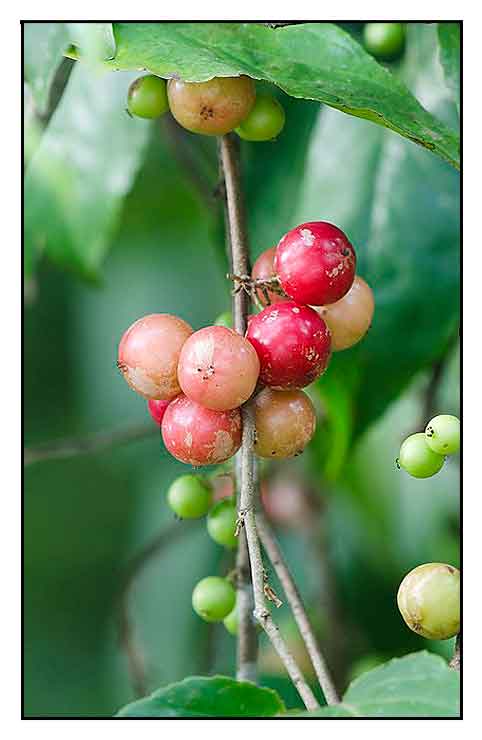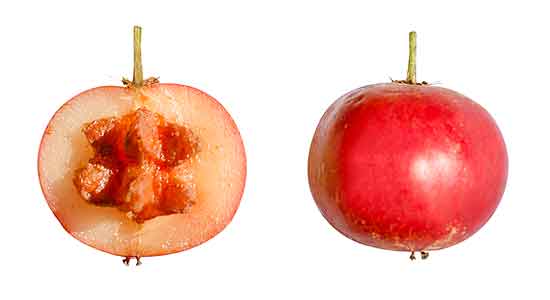 Gen info Gen info
- Genus Flacourtia was named after Etienne de Flacourt, former governor of Madagascar (1607-1660), and was placed in the now defunct family Flacourtiaceae.
Botany
Flacourtia jangomas is a small, deciduous shrub or tree that grows to a height of 6-10m. Trunk and branches are commonly thornless in old trees, but densely beset with simple or branched, blunt woody thorns when younger. Bark is light-brown to copper-red with a flaky texture and the leaves are light green and narrow ovate in shape. It produces small white to whitish green fragrant flowers. The relatively juicy fruits are rounded pink to dark red and about an inch wide.
Distribution
- Introduced.
- Widely cultivated in Southeast and East Asia, and has escaped cultivation in some places.
Constituents
- Stem and bark have yielded two limonoids, limolin and jangomolide. Bioactive compounds including corymbulosine, tremulacin, hydnocarpic acid, chaulmoogric acid have been reported. The fruit and stem bark yielded a coumarin, ostruthin. From the bark, the phenolic glucoside ester, flacourtin, was reported; from the heartwood, a butyrolactone lignan disaccharide, ramontoside, and steroids including ß-sitosterol and its ß-D-glucopyranoside. Fruits are rich in nutrients, protein, fat,, sugars (fructose, α- and ß-glucose and sucrose), amino acids, vitamin C and minerals including calcium potassium, phosphorus, iron, magnesiu8m, sodium, manganese, copper, and zinc. (6)
- Fatty acid analysis have yielded palmitic hexadecadienoic, stearic, oleic, linoleic, alpha-linolenic, and a few minor unidentified acids. Amino acids from dried ripe fruit extracts included proline, hydroxyproline, methionine, alanine, glycine, and valine.
(6)
 - Study of methanol extract of fruits for secondary metabolites yielded flavonoids, phenols, tannins, terpenoids, saponins, with absence of alkaloids. Study for total phenol and flavonoid contents yielded 20 mg/g and 2 mg/g respectively. (7) - Study of methanol extract of fruits for secondary metabolites yielded flavonoids, phenols, tannins, terpenoids, saponins, with absence of alkaloids. Study for total phenol and flavonoid contents yielded 20 mg/g and 2 mg/g respectively. (7)
- Study of leaves and fruits showed total ash, water-soluble ash, and acid-soluble ash to be higher in leaves than fruit. ,Phytochemical analysis of dried leaf and fruit showed presence of alkaloids, glycosides, tannins, flavonoids, steroids, phenols, quinones, lignin, resins, coumarins, carbohydrates, and proteins. Quantitative analysis showed high flavonoid content ( 868.04, 80.91 mg QE/g) followed by tannin (253.10 and 23.96 mg TAE/g) then phenol (144.35, 13.22 mg GAE/g) and alkaloids (4.98, 7.13%) in both leaf and fruit, respectively. (9)
- Study of air-dried fruits for chemical composition in % yielded
moisture 23.05, reducing sugars 4.2, ash 3.46, fat 3.2, potassium 1.26, tartaric acid 0.44, proteins 0.38, phenolics 0.30, nitrogen113 .times. 10-3; iron, 18.37 .times. 10-3; phosphorus, 16.28 times 10-3, ascorbic acid 2.12 times 10-3 and unidentified chemicals, 63.5 (approx). GC analysis of fatty acids in fats revealed the presence (%) of palmitic 31.3, hexadecadienoic 3.3, stearic 5.8, oleic 8.0, linoleic 4.8, .alpha-linolenic 44.5 and a few minor unidentified acids, 2.3. Study for amino acids from aqueous alcoholic extract yielded (in mµ g/g) proline 8.8, hydroxyproline 3.19, methionine 1.17, alanine 0.53, glycine 0.53 and valine 0.3. Paper chromatographic studies on simple reducing sugars and alditol acetates indicated the presence of arabinose, glucose, fructose and galactose. (14)
Properties
- Considered as astringent, acrid, refrigerant, stomachic, diaphoretic, analgesic, anti-inflammatory, antimicrobial.
- Studies have suggest antioxidant,
antimicrobial, antidiabetic, hepatoprotective, analgesic, antidiarrheal, anticorrosive properties.
Parts used
Leaves, roots, fruits.
 Uses Uses
Edibility
- Fruits are edible; eaten raw with a pleasant tart flavor. When astringent, rolling the fruits between the hands is said to reduce astringency.
- Used for making juices, jams, and marmalades.
- In Indonesia, young shoots are eaten.
Folkloric
- Roots, fruits, and leaves used for treatment of diarrhea and dysentery, tumors.
- Dried leaves used for bronchitis; roots used for toothaches.
- Fruits used in bilious conditions, for treatment of bleeding gums, toothaches, diabetes, piles. Also used for jaundice and enlarged spleen.
- Used for asthma, pre- and post-natal blood purification.
- Bark used for intermittent fever. Bark infusion used as gargle to alleviate hoarseness.
- Leaves are astringent and stomachic.
- In Malaysia, juice squeezed from roots used to treat herpes infections.
- In Bangladesh, fruit endosperm is consumed to maintain kidney function. Fruit eaten as remedy for fish thorn in the throat. (12)
Others
- Wood: Hard, closed grained, durable, and polishes well. used for making small utensils and agricultural tools.
Studies
• Proximate Composition of Raw and Heat-Treated Fruits: Heat treatment involves blanching, steaming, boiling, and microwave cooking. Study showed heat treatment caused significant difference (p<0.05) on proximate composition of fruit except for ash and crude fat. Boiled and steamed fruits showed high moisture content, and lowest in microwave-cooked. Crude protein and fiber showed increased values compared to raw seriales fruits. (2)
• Antidiabetic / Toxicity Studies / Leaves and Stems: Study evaluated the efficacy of combination of leaf and stem methanolic extract in STZ-induced diabetic rats at dose of 400 mg/kg. Acute oral toxicity study using OECD/OCED guideline 425 showed no toxic symptoms up to dose of 2000 mg/kg. Administration for 21 days showed highly significant (p<0.01) hypoglycemic activity and significant (p<0.05) correction of altered biochemical parameters (cholesterol and triglycerides). Glibenclamide was standard drug. Results suggest the methanolic extract of leaf and stem possess antidiabetic activity and further studies to isolate hypoglycemic principles are warranted. (8)
• Antioxidant / Nutrient Composition / Fruit: Study evaluated the nutrient composition and antioxidant activity of Flacourtia jingomas fruit. Ethanol extracts showed highest total phenolic content (2507.41 mg GAE/100g). Antioxidant activities using DPPH highly correlated with total phenolic content (r=1.000) and with reducing power using FRAP assay (r=0.968). High antioxidant activity with hight ascorbic acid, carbohydrate content and calcium content suggested F. jangomas can be a good source for preparation of a health drink. (10)
• Hepatoprotecetive / Paracetamol Induced Toxicity / Cytotoxic / Leaves and Fruit: Study investigated the cytotoxic and hepatoprotective activity of F. jangomas methanolic extract of fruit and leaves on paracetamol induced toxicity in HepG2 cell line using measures of AST, ALT, LDH and MDA levels. Increased cell viability of 140.43% and 133.93% was observed in HepG2 cells treated with the methanolic extract of leaves and fruit, respectively at 10 µg/ml concentration, which decreased as concentrations increased. The levels of LDH, ALT, AST, and MDA decreased after leaf and fruit treatment compared to negative control. (11)
• Antimicrobial / Antioxidant / Stem: Study of ethyl acetate extract of stems by agar diffusion method showed profound effect on gram-negative bacteria with highest zone of inhibition of 28 mm against Pseudomonas aeruginosa followed by Vibrio cholerae with 20 mm. Against four fungal strains viz. Aspergillus niger, A. flavus, Trichoderma viridae, and Neurospora crassa, the extracts showed moderate inhibitory activity ranging from 2-15 mm. Antioxidant activity by Nitric Oxide scavenging assay showed prominent activity with BHA as standard. (13)
• Silver Nanoparticles / Antibacterial / Fruit: Study reports on the synthesis of silver nanoparticles using aqueous extract of ripe fruit of F. jangomas as reducing agent. The Fj-AgNPs showed enhanced antibacterial effect compared to Am-NPs (ammine modified NPs). Study suggests the aqueous extract of ripe fruit could be a replacement of EDTA in the synthesis of AgNPs. (15)
• Inhibition of Mild Steel Corrosion: Study evaluated the inhibition of corrosion of mild steel using Paniala (Flacourtia jangomas) extract in 1M HCl and 0.5 H2SO)4 solutions by measure of weight loss method at 30°C. Results showed corrosion rate was significantly decreased in the presence of the extract and inhibition efficiency increased with increasing concentration of the extract. (16)
• Analgesic / Antidiarrheal / Leaves: Study evaluated ethanol extract of leaves for analgesic, antioxidant, and antidiarrheal activities. The extract exhibited significant inhibition of DPPH radical scavenging activity in a concentration dependent manner with IC50 of 11 µg/mL compared to ascorbic acid IC50 of 5 µg/ml. Total phenol content was 601.03 mg GAE/100 g dried plant material. In reducing power assay, the extract showed strong ferric reducing power in a concentration dependent manner. In acetic acid induced writhing test, the extract at 250 and 500 mg/kg exhibited (p<0.001) inhibition of writhing reflex in a dose dependent manner, which was comparable to standard diclofenac sodium Pain threshold was significantly increase (p0.001) in hot plate test. In invivo antidiarrheal test using castor oil induced diarrhea model, there increased in onset of diarrhea and decreased total number of stools in significant (p<0.001) and dose dependent manner. (17)
Availability
Wild-crafted.
Cultivated.
|

![]()




 - Study of methanol extract of fruits for secondary metabolites yielded flavonoids, phenols, tannins, terpenoids, saponins, with absence of alkaloids. Study for total phenol and flavonoid contents yielded 20 mg/g and 2 mg/g respectively. (
- Study of methanol extract of fruits for secondary metabolites yielded flavonoids, phenols, tannins, terpenoids, saponins, with absence of alkaloids. Study for total phenol and flavonoid contents yielded 20 mg/g and 2 mg/g respectively. (
